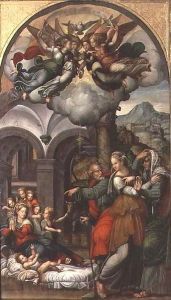Pellegrino (Munari) Aretusi Paintings
Pellegrino Aretusi, also known as Pellegrino di Mariano dei Munari, was an Italian painter of the Renaissance period, born in 1460 in Modena, Italy. Aretusi is often remembered for his contributions to the development of the Renaissance style in Northern Italy, particularly in his native Modena and in Parma. His artistic journey is characterized by a blend of local traditions and the influence of major Renaissance centers, such as Florence and Rome, reflecting the broader cultural exchanges of his time.
Initially trained in Modena, Aretusi's style was heavily influenced by the works of the early Renaissance masters, including the likes of Lorenzo Costa, with whom he is believed to have studied. His early works are marked by a meticulous attention to detail and a keen interest in exploring the human form, themes typical of the Renaissance's humanistic approach. Aretusi's talent soon led him to Rome, where he became involved in the vibrant artistic scene of the late 15th and early 16th centuries. In Rome, he was exposed to the works of Raphael and Michelangelo, which had a profound impact on his artistic development, leading him to incorporate elements of their styles into his own.
Aretusi's work is characterized by its dynamic compositions, vibrant color palette, and the emotional depth of its subjects. He was adept at both religious and secular themes, demonstrating versatility across different forms of art, including fresco and oil painting. Among his notable works are the frescoes in the Cathedral of Modena and his contributions to the decoration of the Palazzo Ducale in Modena, which exemplify his skill in integrating architectural elements with figurative compositions.
Despite his achievements, Pellegrino Aretusi's work was somewhat overshadowed by the luminaries of the High Renaissance, and for many years, his contributions were not as widely recognized outside of his regional context. However, modern scholarship has begun to re-evaluate Aretusi's place in the history of Italian Renaissance art, highlighting his role in the dissemination of Renaissance ideals beyond the major centers of Florence, Rome, and Venice.
Pellegrino Aretusi passed away in 1522 in Modena. Today, his legacy is appreciated for its contribution to the spread of Renaissance art and ideas in Northern Italy, and his works are considered important examples of the period's artistic achievements. Aretusi remains a significant figure for scholars interested in the nuances of regional art movements and the interplay between local traditions and the overarching trends of the Italian Renaissance.
